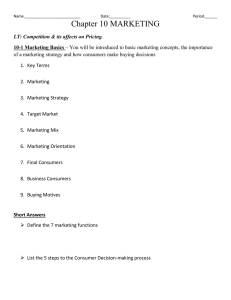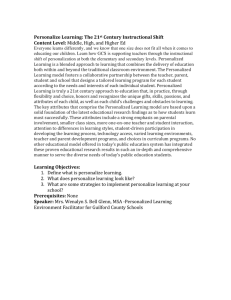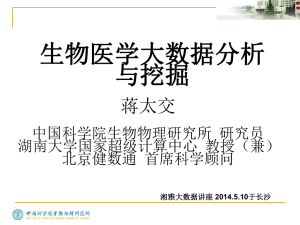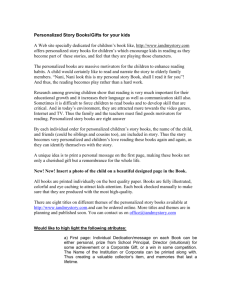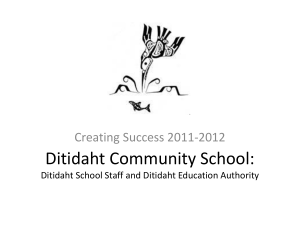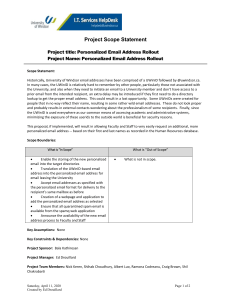Executive Summary Continued Progress Promising Evidence on Personalized Learning
advertisement
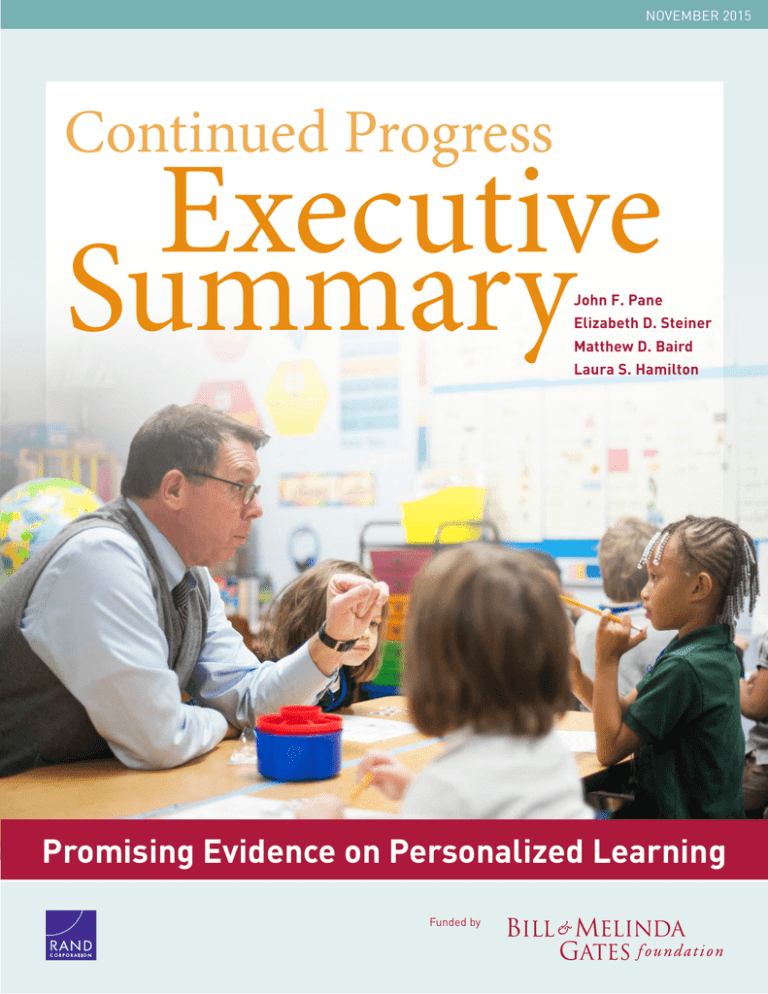
NOVEMBER 2015 Continued Progress Executive Summary John F. Pane Elizabeth D. Steiner Matthew D. Baird Laura S. Hamilton Promising Evidence on Personalized Learning Funded by Executive Summary The Bill & Melinda Gates Foundation has engaged RAND to carry out an ongoing study of foundation-funded schools that are employing promising approaches to personalized learning. This research is part of the foundation’s public commitment to spread effective practices across districts and charter networks, develop innovative roles for teachers, and support implementation of college-ready standards. This is the second report in a series focused on the achievement data, school design characteristics, and teacher and student perceptions of schools that are implementing personalized learning. The achievement findings in this report focus on 62 public charter and district schools that are pursuing a variety of personalized learning practices. In a smaller set of 32 schools, the report examines details of personalized learning implementation and the relationship of implementation to outcomes. The concept of personalized learning has been around for some time, but the adoption of personalized learning Characteristics of schools in this year’s study 62 in part to rapid advances in technology platforms and digital schools (including five district schools) years predominantly urban Student population 2 content. Although there is not yet one shared definition of personalized learning, leading practitioners in the field generally look for the following: (1) systems and approaches that accelerate and deepen student learning by tailoring About 11,000 1-3 approaches has increased significantly in recent years due students instruction to each student’s individual needs, skills, and interests; (2) a variety of rich learning experiences that collectively prepare students for success in the college and career of their choice; and (3) teachers’ integral role in student implementing personalized learning practices learning: designing and managing the learning environment, leading instruction, and providing students with expert guidance and support to help them take increasing ownership of their learning. Although these core principles are common among the locations schools in the study, there is considerable diversity in the details of the schools’ instructional models because innovation was encouraged in the competitive grant programs Predominantly from low-income families Continued Progress Promising Evidence on Personalized Learning they participated in. Each school received funding after rigorous evaluation of its leadership team and instructional vision as part of at least one of the following three Gates foundation-supported initiatives: Next Generation Learning Challenges (NGLC), Charter School Growth Fund’s Next Generation School Investments, and the Gates Foundation’s Personalized Learning Pilots. (See the full report for more Students made significant gains in mathematics and reading, overall and in elementary and middle schools Fall 2013 to Spring 2015 0.5 detailed descriptions of these initiatives.) Students made gains in mathematics and reading that were significantly greater than a comparison group made up of 0.4 0.3 Effect Size1 Student Achievement Results results are consistent with the findings reported last year but mathematics and reading at schools that have implemented -0.2 personalized learning approaches were relatively large positive results. Importantly, although students started out mostly performing below the national averages in mathematics and reading, they generally ended with scores near or above the national averages after two years in personalized learning schools.These results suggest that the effects of personalized learning on student achievement are promising. 0.1 -0.1 with a sample nearly three times as large. The gains in both of interventions. A majority of the schools had statistically 0.2 -0.0 similar students selected from comparable schools. These compared with gains in studies of schools with other types ■ Mathematics ■ Reading Percentile Gain2 All Schools 11 8 Number of 11,217 10,906 Students Grades K–5 Grades 6–8 Grades 9–12 13 8 6 7 4 5 7,742 7,577 2,593 2,391 882 938 Solid bars indicate statistical significance (p < 0.05) after adjustment for multiple hypothesis tests. Outlined bars are not significant. 1 Percentile gains translate the treatment effect sizes into the amount of improvement experienced by the median student. 2 Note: Effect size is a standard way researchers measure the impact of an educational strategy. Continued Progress Promising Evidence on Personalized Learning 3 School Design Characteristics The implementation findings rely on data collected in quizzes, presentations, software, or non-cognitive factors) schools implementing personalized learning with funding are used to understand student progress. from the NGLC program. There are 32 such schools that also administered the Northwest Evaluation Association’s Measures of Academic Progress mathematics and reading assessments during the 2014–15 school year. The schools are located predominantly in urban areas with the exception of two rural schools. They tend to serve large proportions of minority students from low-income families. The schoollevel median of students of color is 75 percent, and the school-level median of students eligible for free or reducedprice lunch is 80 percent. Teachers reported using a variety of data and other resources to inform their instructional decisions, and all administrators reported that their schools used data from different sources to understand student progress. About half of administrators reported that their schools were developing personalized goals for students, and two-thirds were providing data to and discussing data with students. PERSONAL LEARNING PATHS hold all students to high expectations, but the school model allows for flexibility in the path that students take through the content. Students are able to make choices about the content or structure “There’s a whole lot of support systems in [this school]. Everybody supports you and they look out for you, make sure that you got your head on your shoulders and you know what you’re doing.” of learning, and the school uses a variety of instructional approaches and curriculum materials to meet the learning needs of all students. In addition, there is time during the school day for one-on-one academic supports for students that are tailored to their learning needs, and there are opportunities for students to engage in meaningful learning experiences outside of school. Administrators reported that the extent to which students were able to make choices about their learning varied by course, teacher, and age of the student. Administrators and teachers identified project-based learning approaches Although the schools have considerable diversity in their models of personalized learning, the Gates foundation, along with other funders and leaders in the personalized learning space, identified five strategies that are often present in the schools. As the following descriptions suggest, each strategy encompasses a set of tools and features of the personalized learning environment. Some of these, such as the provision of flexible pathways, are central to a personalized approach, whereas others (e.g., use of technology) might be viewed more as enablers of personalized learning. We find this personalized path through content. All schools provided time for individual academic support, which emphasized teaching developmentally appropriate content. Three-quarters of schools used a variety of instructional formats and offered out-of-school learning opportunities. Implementation of innovative, out-of-school learning opportunities was less common, and the opportunities offered were typically not technology-enabled or substantially different from traditional environments. framework to be a useful way to organize discussion of COMPETENCY-BASED PROGRESSION continuously school design features and implementation. assesses each student’s progress toward clearly defined LEARNER PROFILES give teachers an up-to-date record that provides a deep understanding of each student’s individual strengths, needs, motivations, progress, and goals to help inform his or her learning. Teachers work with students to understand their data and create individual goals. Data from multiple sources (e.g., projects, tests, 4 as one way of providing students with choice and with a Continued Progress Promising Evidence on Personalized Learning goals, and assessment occurs “on demand” when a student is ready to demonstrate competency. Assessment may take a variety of forms, such as projects or presentations, as well as more traditional tests and quizzes. Students advance through the content at their own pace as they demonstrate competency. Students’ ability to work at their own pace and advance when reported holding unconventional roles such as co-teaching, they had mastered the material was limited by a perceived job sharing, or working with small groups of students need to emphasize teaching grade-level content. This primarily under the supervision of another teacher. emphasis was driven by a desire to ensure that students were progressing toward grade-level standards and external policy constraints such as standardized testing. Fewer schools seemed to be implementing competency-based progression than were implementing other personalized learning strategies. EMPHASIS ON COLLEGE AND CAREER READINESS as a personalized learning strategy means that a school’s curriculum, activities, and programs develop academic and non-academic college and career readiness skills. Some examples are college visits, career surveys, career-oriented internships, college-level courses, or encouragement of FLEXIBLE LEARNING ENVIRONMENTS use resources college expectations. Aspects of curriculum, activities, such as staff, space, and time in flexible ways to or programs (including student advisory strategies) are support personalization. For example, classroom size, intended to develop students’ skills and competencies organization, or furniture does not hinder implementation beyond academic content. These are referred to variously as of personalized learning. The structure of learning time is “habits of mind,” “learner identity,” “student agency,” “non- responsive to student needs. Student grouping strategies cognitive skills,” etc. are flexible, responsive to student needs, and based on data. Technology is a key aspect of the school model and is available to all students. All schools incorporated ways to develop non-academic skills in preparation for life after high school into the curriculum in some way, often through advisory curricula Teachers generally reported that the learning space was and cooperative learning opportunities, such as group supportive of personalized learning. About three-quarters of projects. Administrators of schools at all grade levels said administrators reported that learning time was structured they were developing students’ awareness of, and knowledge in a way that was flexible and responsive to student needs. about, postsecondary opportunities. In schools with younger Most schools had extended school days or school years, students, this generally consisted of activities such as and they used the extra time primarily for additional providing information about college, talking about college, mathematics or English language arts (ELA) instruction and developing a belief that college is attainable. In schools or to provide individualized support. Educators at many of with older students, these activities typically took the form the schools were thinking flexibly about how staff are used of traditional college counseling, college visits, and in some for instruction and student support. One-fifth of teachers high schools, opportunities to earn college credit. Continued Progress Promising Evidence on Personalized Learning 5 CONTEXTUAL FACTORS can influence personalized learning implementation. High-quality supports for teaching are relevant to the implementation of all five strategies. Teachers expressed positive opinions about colleague and administrator support and about the quality and usefulness of the professional development they received. However, a majority of administrators identified teacher staffing as a challenge. This was particularly true for schools that opened in 2012. The administrators cited high staff turnover as a common problem. Site visit participants suggested that mid-year The adoption of personalized learning approaches has increased significantly in recent years due in part to rapid advances in technology platforms and digital content. teacher departures were disruptive, particularly in new schools, which tended to have smaller staffs. Relating Implementation to Outcomes While no single element of personalized learning was able strategies driven by data and responsive to student needs; (2) to discriminate between the schools with the strongest providing data to students and including them in discussions achievement outcomes and the others in the sample, we did about how the data relate to the students’ personal learning identify three elements that, when present together, were goals; and (3) learning spaces that are supportive of, or do able to do so. Among all the schools in the analysis, the most not hinder, implementation of other personalized learning successful schools were the only ones that showed strong strategies. evidence of implementing all three: (1) student grouping National Comparison of Survey Results This study compared the teacher and student survey results The use and characteristics of learner profiles and emphasis from the 32 schools in the implementation analysis to results on student choice in the personalized learning schools from administering nearly identical questions to a national were similar to those in the national sample. However, sample of teachers and students. Grunwald Associates teachers in personalized learning schools were more administered the national survey during summer 2015. likely than those in the national sample to use technology The national results are intended to provide context for the for personalization and to report that their school’s data findings from the personalized learning schools to help system is useful. Teachers in the personalized learning understand the ways in which the experiences of students and sample also reported greater use of instructional practices teachers in these schools differed from the experiences of that support competency-based learning. Students in students and teachers nationally. To facilitate this comparison, both samples agreed or strongly agreed that there was an we first weighted the national survey results to more emphasis on making them aware of instructional goals and closely reflect the personalized learning sample in terms of tracking progress toward mastery. Finally, students in the geographic locale (e.g., urban), grade level, subject taught personalized learning schools were more likely to report that (by teachers), and gender (of students). However, we lacked they were able to make choices about their learning and that the necessary data to include family income in the student their mathematics and ELA instruction incorporated aspects survey weighting process and the national sample appears to of complex, student-centered instruction. be somewhat more affluent than the personalized learning sample. 6 Continued Progress Promising Evidence on Personalized Learning Conclusions Although implementation of personalized learning varied considerably across the 32 schools studied, our findings suggest that the schools were employing a number of practices that support personalization. Teachers at most schools were using data to understand student progress and make instructional decisions, all schools offered time for individual academic support, and the use of technology for personalization was widespread. However, some strategies, such as competency-based progression, were less common and more challenging to implement. The schools that exhibited the greatest achievement growth were all implementing three elements of personalized learning— student grouping, learning spaces that support personalized use caution in interpreting these results as causal effects of learning, and opportunities for students to discuss their personalized learning. Although the analyses used the best learning data with teachers. estimation strategies possible given the nature of the data The achievement findings are largely positive and promising. They indicate that compared to peers, students in schools using personalized learning practices were making greater and limits to implementing a strong experimental design, it was not possible to separate personalized learning effects from other potential school effects. progress over the course of two school years and that RAND will produce a more comprehensive report with those students who started out behind were catching up additional details in 2016. to perform at or above national averages. We conducted a set of rigorous sensitivity analyses and concluded that they generally support these results. However, it is important to About the Comparison Group Despite the increased interest in personalized learning, the field lacks evidence about its effectiveness. This study is designed to address this need using the most rigorous method that could be applied in the circumstances, namely a matched comparison group. Northwest Evaluation Association, through its standard service known as “virtual comparison group” (VCG), drew on its large national database of testing data to identify students who had starting performance similar to the personalized learning students and who were attending schools serving similar populations. This enabled us to make “apples to apples” comparisons of learning growth between the students at the personalized learning schools and a similar population of students attending other schools. The observable characteristics of the comparison students were well matched to those of personalized learning students in the 62 schools in the achievement analysis. However, the comparison students could possess other unidentified or unobserved differences from the personalized learning students that could confound efforts to measure the impact of the personalized learning environment. Such differences could bias our estimates of personalized learning treatment effects in either direction. The VCG approach also assumes that the students in the comparison groups are attending more traditional schools that are not using personalized learning practices, but there is no way to verify this assumption. Continued Progress Promising Evidence on Personalized Learning 7 The RAND Corporation is a nonprofit institution that helps improve policy and decisionmaking through research and analysis. Guided by the belief that every life has equal value, the Bill & Melinda Gates Foundation works to help all people lead healthy, productive lives. In developing countries, it focuses on improving people’s health and giving them the chance to lift themselves out of hunger and extreme poverty. In the United States, it seeks to ensure that all people—especially those with the fewest resources—have access to the opportunities they need to succeed in school and life. Based in Seattle, Washington, the foundation is led by CEO Susan Desmond-Hellmann and Co-chair William H. Gates Sr., under the direction of Bill and Melinda Gates and Warren Buffett. To download the Continued Progress report, visit www.rand.org/t/RR1365. RR-1365-BMGF/1 November 2015 © Copyright 2015 RAND Corporation. This work is licensed under a Creative Commons Attribution 4.0 International License (CC BY 4.0). This report is based on research funded in part by the Bill & Melinda Gates Foundation. The findings and conclusions contained within are those of the authors and do not necessarily reflect positions or policies of the Bill & Melinda Gates Foundation. www.gatesfoundation.org CHILDREN AND FAMILIES EDUCATION AND THE ARTS The RAND Corporation is a nonprofit institution that helps improve policy and decisionmaking through research and analysis. ENERGY AND ENVIRONMENT HEALTH AND HEALTH CARE INFRASTRUCTURE AND TRANSPORTATION This electronic document was made available from www.rand.org as a public service of the RAND Corporation. INTERNATIONAL AFFAIRS LAW AND BUSINESS NATIONAL SECURITY POPULATION AND AGING PUBLIC SAFETY SCIENCE AND TECHNOLOGY TERRORISM AND HOMELAND SECURITY Support RAND Browse Reports & Bookstore Make a charitable contribution For More Information Visit RAND at www.rand.org Explore the RAND Corporation View document details Research Report This report is part of the RAND Corporation research report series. RAND reports present research findings and objective analysis that address the challenges facing the public and private sectors. All RAND reports undergo rigorous peer review to ensure high standards for research quality and objectivity. Distribution Rights Reports funded by the Bill & Melinda Gates Foundation are published on “Open Access” terms, under the Creative Commons Attribution 4.0 Generic License (CC BY 4.0) or an equivalent license. All users of the publication are permitted to copy and redistribute the material in any medium or format and transform and build upon the material, including for any purpose (including commercial) without further permission or fees being required.

